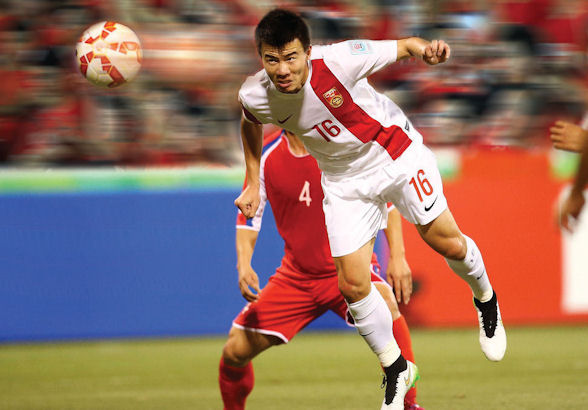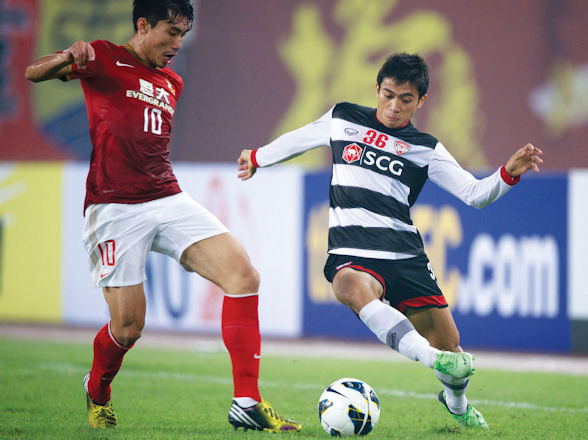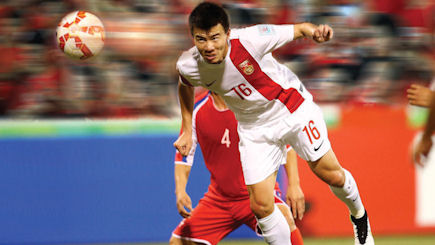This article first appeared in the Mar/Apr 2015 issue of WGM.
The unexpected success of the Chinese national team at this year’s Asian Cup provided their travelling media with some headaches. Most had booked flights home for immediately after the group stage and finding hotel rooms at the last minute was no easy task. After all, a decade of extreme mediocrity had done little to raise hopes of a sudden resurgence. Yet that’s exactly what happened as China proceeded to win all three of its group games to top their group! After years of nothing but disappointment and scandal, is the sleeping dragon finally waking from its slumber?

Sun Ke starred for China at the 2015 Asian Cup
It looks like a new dawn of Chinese football is coming, or so the nation’s army of football fans is hoping. Although they were ultimately bundled out in the quarter-finals by eventual champions Australia, coach Alain Perrin can already lay claim to having performed a minor miracle – taking charge of a side in complete disarray and within 12 months leading them to their best ever group stage performance.
But more exciting for fans of Team Dragon is the fact that so many of their best performers in the Asian Cup are still under 25 years of age. They include Sun Ke, who scored three goals in the group stage, Wang Dalei, Wu Lei, Zhang Chengdong and Zhang Linpeng.
In stark contrast to the older generation of Chinese footballers, these rising stars are courageous, quick on the ball and have a strong physique. Zhang Linpeng has even been nicknamed the “Chinese Ramos” after the powerful Real Madrid defender – the pair sharing a similar physique, playing style and body tattoo!
Luck was on China’s side in the lead-up to the tournament when they managed to avoid Asia’s “big three” of Japan, South Korea and Australia in the group stages but they were still widely tipped to finish behind three-time Asian Cup champions Saudi Arabia – who beat them 2-1 during qualifying – and Uzbekistan. Instead, China beat both to seal their spot in the quarter-finals even before they had faced group minnows North Korea in their final group match.
Perrin deserves plenty of credit for the manner in which he has approached the role. While foreign coaches have previously spent much of their tenure battling against the Chinese FA and its bureaucratic style of management, the Frenchman instead focused his energies on maximizing the resources at his disposal.
The set-up of the national team under Perrin’s watch is particularly interesting. As well as placing greater reliance on youth, 13 of the 23 players in their 2015 Asian Cup squad came from just two clubs in order to aid combinations and consistency. Captain Zheng Zhi – the only squad member over 30 – and six others play for 2013 Asian Champions League (ACL) winners Guangzhou Evergrande while another six ply their wares for fellow ACL regulars Jiangsu Guoxin-Sainty.

China’s national team captain Zheng Zhi (left) playing for Chinese Super League giants Guangzhou Evergrande
This makes sense given the two are among China’s richest clubs and share the record for the biggest ever crowd at a Chinese Super League (CSL) game. Their clashes regularly attract 60,000 fans and Perrin explained when he announced his squad that he had picked players with enough experience to perform in big matches.
Other factors have contributed to their improvement too. The expansion of the ACL in 2009 saw China’s annual allocation rise from two clubs to four, while the recent influx of riches into the CSL – most notably at Guanzhou Evergrande who were bought out by real estate giants Evergrande Real Estate in 2010 – has seen the likes of Didier Drogba and Nicolas Anelka lured across from Europe. Only last month Guangzhou signed 23-year-old Brazilian star Ricardo Goulart Pereira – who made his international debut for Brazil in August – on a CSL record US$17.7 million transfer fee. And Australian great Tim Cahill announced after his nation’s Asian Cup triumph that he too would be heading to China this year to join Shanghai Shenhua.
Given China’s previous two efforts at the Asian Cup in 2007 and 2011 when they were dumped out in the group stages, it’s likely there was a dark horse factor at play this time around with their new-look squad and throng of ex-pat fans in the stands catching their opponents by surprise.
Even the 2-0 loss to Australia in the quarters where their shortcomings in technique and physique were exposed hasn’t dented Chinese optimism.
This is because Chinese football has for so long been considered a laughing stock. A national joke explains, “The Buddha tells the people he can fulfil just one of their wishes so someone asks, ‘Could you lower the price of property in China so that people can afford it?’ Seeing the Buddha frown in silence, this person makes another wish instead – ‘Could you make the Chinese football team qualify for a World Cup?’ After a lengthy sigh, the Buddha says, ‘Let’s talk about property prices’.”
But there are two very good reasons to believe Chinese football really is on the rise. First is the progress of the CSL after its early years were plagued by corruption scandals, bribery allegations and dubiously terrible refereeing. A concerted anti-corruption movement implemented by the Chinese government in 2010 has seen the league’s image improve dramatically and enticed much greater investment in the sport with a number of once struggling clubs now owned by big business. Huge money is invested into the league, with Guangzhou Evergrande the biggest spender. Although there remain legitimate concerns the CSL is relying too heavily on these cashed-up owners, the resources they currently provide have opened many more pathways for young players to develop.

Secondly, after years of failure by the FA to develop school football, the Ministry of Education took over this vital task last year and has vowed to create four school football leagues at Primary, Junior High, High and College levels. They have also promised to increase the number of schools and colleges with specialist football training facilities from 5,000 to 20,000 within three years.
With rivals Japan and South Korea continuing to demonstrate the benefits of similar programs, China is hoping to close the gap by getting kids involved from a much earlier age.
Of course, whether this positive momentum signals a bright new era or proves little more than a false dawn remains to be seen and when it comes to Chinese football questions must still be raised.
Behind its big bubble, the current CSL model appears a relatively unstable one with 13 of the 16 clubs currently owned by wealthy real estate developers. This potentially creates a huge problem should the real estate market nosedive.
It also places the fate of these clubs at the mercy of their owners. The exemplar of this was Dalian Wanda FC, so named after being purchased by the Dalian Wanda group in 1994, who quickly became China’s most successful club with eight domestic league titles. However, after Dalian Wanda Group Chairman Wang Jianlin sold the club in 2000 in protest over a lack of action against match-fixing, they began to run into financial trouble and in 2012 was eventually forced to merge with local rivals Dalian Aerbin FC. Their dramatic fall from grace was complete last year when they finished 15th and were relegated.
Meanwhile, Wang has recently rekindled his involvement in football, but not in China – buying instead a 20 percent share in Spanish champions Atlético Madrid for €40 million!
Unfortunately, the city of Dalian shows us the sad reality of football’s history in China. The Chinese FA’s ineptitude in dealing with corruption and bribery within its own league is appalling – and should we really expect significant change in schools under the Ministry of Education?
The current condition of school football is unexciting to say the least. This writer recently had the opportunity to visit some so-called traditional footballing schools in Fujian province and discovered their idea of a football demonstration was in fact hundreds of kids performing gymnastics with a football in their hands! In other schools, headmasters complained about a lack of experienced football coaches or decent facilities. Another hurdle is the size of school classes which average 50 kids in most cities in China. Organizing football training for 50 kids at a time is a formidable challenge for even the most experienced coaches.
These are the foundations that must be addressed if China is ever to become a genuine player on the global football stage, but let’s hope their stirring performance at the 2015 Asian Cup can spark similar support at all levels as Ding Junhui’s emergence in 2005 did for snooker.
The dragon hasn’t taken flight just yet but at least it is finally starting to stir.







